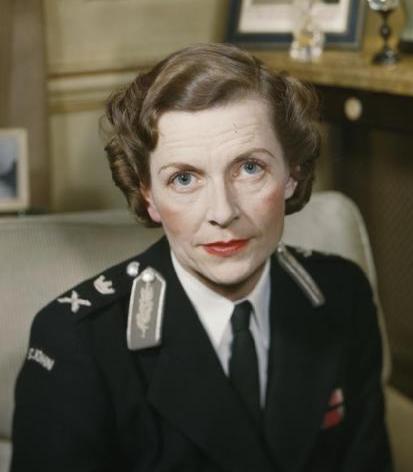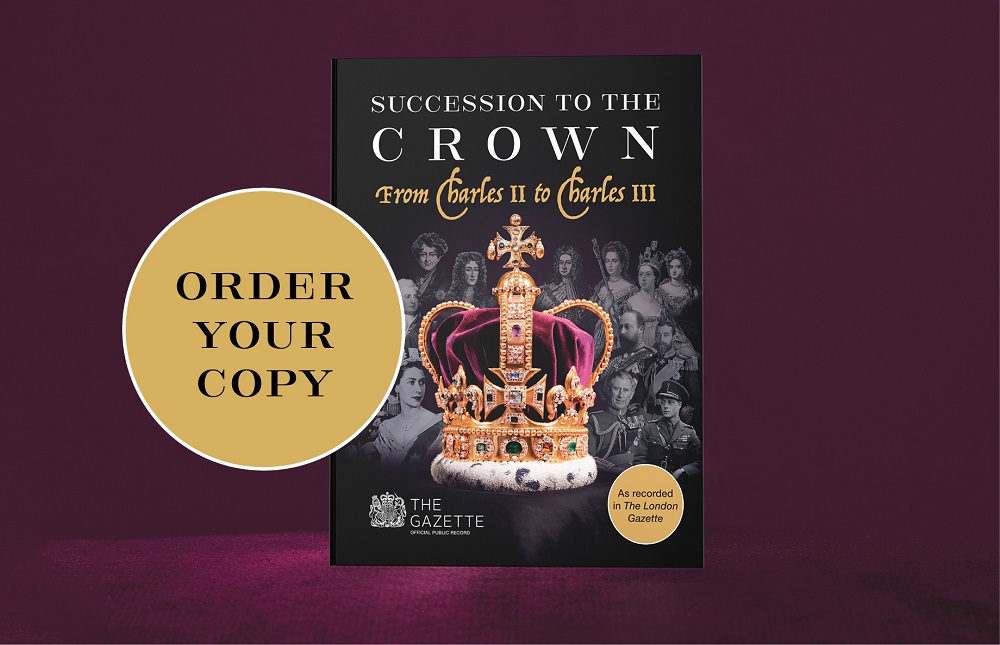Demise of the Crown: #28: The Mountbattens

As the official public record since 1665, The Gazette has been recording the deaths of monarchs for over three centuries. As part of our ‘Demise of the Crown’ series, historian Russell Malloch looks through the archives at The Gazette’s reporting of demise events of the Mountbatten family.
By the time the Princess of Wales died in Paris in the summer of 1997, the name of the royal house was Windsor, although for almost three decades the surname of certain members of the family had been Mountbatten-Windsor, in accordance with a declaration the Queen gave at a meeting of the Privy Council in 1960 (Gazette issue 41948).
The Gazette reported events in the lives of several members of the royal family, who used the name Mountbatten, which was crafted for the princes of Battenbergs during the first world war. The Gazette also reported the first in a sequence of Battenberg-Mountbatten resting places on the Isle of Wight that began in 1896, with the ceremony at Whippingham near Osborne House for Queen Victoria’s son-in-law Prince Henry of Battenberg.
The later Mountbatten funerals took place at a time when the reports of such services were noticed in the Court Circular, but no longer gazetted. During Elizabeth II’s reign, this meant that The Gazette did not record the ceremonies that followed three Mountbatten deaths, all of which occurred in exceptional circumstances, as Edwina, Countess Mountbatten of Burma, died while carrying out humanitarian work in the Far East; her husband Louis Mountbatten, was killed by Irish nationalists; and his cousin Philip, Duke of Edinburgh, died during a global pandemic.
Battenberg inheritance
The introduction of the Mountbatten surname affected two branches of George V’s Battenberg relations, who surrendered their German “degrees, styles, dignities, titles, honours and appellations” during the first world war (Gazette issue 30186). The changes in 1917 impacted on two lines of descent from Prince Alexander of Hesse: those of his eldest son, known as Louis of Battenberg, who married Queen Victoria’s granddaughter, Victoria of Hesse, and those of his younger son Henry of Battenberg, who married the Queen’s daughter Beatrice.
Louis of Battenberg was created marquess of Milford Haven and had two sons: George who inherited the title, and Louis who became the Earl Mountbatten of Burma. He also had two daughters: Alice who married Prince Andrew of Greece, and was the mother of the Duke of Edinburgh, and Louise who was the second wife of a future king of Sweden.
Henry of Battenberg had three children who survived to see the Mountbatten name being adopted. His eldest son Alexander became the marquess of Carisbrooke, while his daughter Victoria Eugenie married the king of Spain. Another son Maurice was killed in action in 1914.

The Battenberg-Mountbatten association with Whippingham was maintained after Prince Henry’s death, as it became the resting place for the Marquess of Milford Haven, who was the first sea lord at the start of the war and promoted to the senior naval rank shortly before his death. At his funeral in Westminster Abbey in 1921, the King was represented by the Duke of Connaught, and the pall bearers included Lord Beatty and other admirals of the fleet. Later that day, the coffin was taken to Whippingham, where it was received by Princess Beatrice, the widow of Henry of Battenberg, in her role as governor of the Isle of Wight.
The next Mountbatten funeral was for Louis of Battenberg’s eldest son, but did not involve the use of St George’s Chapel or Whippingham. Instead, the second marquess of Milford Haven was buried in St Michael’s Church at Bray, near Maidenhead. His funeral in 1938 was attended by the King in the dress uniform of an admiral of the fleet, and the maritime theme continued with naval pall bearers, and a naval crew taking the gun carriage to the village churchyard. The men came from HMS Excellent, which had provided the detachments for the sovereign’s funeral in 1901, 1910 and 1936.
Whippingham was used for the next Mountbatten loss, as Princess Beatrice’s funeral was held in St George’s in November 1944, and in August of the following year her remains were moved to lie beside those of her husband. The ashes of their eldest son, Alexander of Battenberg who took his title from Carisbrooke on the Isle of Wight, were placed in an urn beside their tomb in 1960.
The remains of Princess Beatrice’s other children were interred at various locations. Maurice was commemorated by a soldier’s stone in France, while Leopold died in 1922 and was initially buried in the Georgian crypt, but later transferred to Frogmore under the “Rule of 1928”. The last family member was Victoria Eugenie, the Dowager Queen of Spain, whose body was buried in Switzerland in 1969, and lay there until after the restoration of the Spanish monarchy, when it was placed in the vault of the Escorial Palace near Madrid, by which time her grandson was King Juan Carlos I.
As regards the Mountbatten daughters, the passing of Queen Louise of Sweden was an event of national rather than family importance, and Elizabeth II was represented by her aunt, the Princess Royal, at the funeral service in Stockholm in 1965, which was attended by the kings of Denmark and Norway, and the presidents of Finland and Iceland.
The funeral of the last of Louis of Battenberg’s daughters was a more modest affair. Princess Andrew of Greece, who was the mother of Philip, Duke of Edinburgh and grandmother of King Charles III, died at Buckingham Palace. Her funeral was held in St George’s Chapel in 1969, and her remains were deposited in the royal vault at Windsor, but almost two decades later they were removed to lie in a Russian Orthodox church in Jerusalem.
Whippingham provided the burial place for Louis of Battenberg’s widow and followed the service for the dowager Marchioness of Milford Haven – the Duke of Edinburgh’s grandmother – that was held in the Chapel Royal at St James’s Palace in 1950.

Mountbatten of Burma
The lives of two members of the Mountbatten family had an ending that involved the sea, as Edwina, Countess Mountbatten of Burma, was buried at sea in 1960, while her husband Louis was assassinated while he was on holiday off the Irish coast almost two decades later.
Edwina Mountbatten died in North Borneo, while on active service with the Order of St John, of which she had been a dame grand cross since 1945 (Gazette issue 37417). Her body was returned to England, and lay in Romsey Abbey, near the family’s home at Broadlands in Hampshire. A few days later her coffin was taken to Portsmouth and put on board HMS Wakeful for its maritime end, which happened within sight of the Isle of Wight. There was also a more conventional, land-based memorial service for Lady Mountbatten a few weeks later in Westminster Abbey.
As was customary, the memorial services for the departed Mountbattens were attended by members of the wider royal family, or their representatives. In 1960, for example, the Queen’s aunt Mary, Countess of Harewood (the Princess Royal), was represented by her son Gerald Lascelles at the abbey service for Edwina Mountbatten on 7 March, and four days later he stood in for his mother at the St George’s Chapel event for the Marquess of Carisbrooke.
By the time of his assassination in 1979, the last of Louis of Battenberg’s children, by now the Earl Mountbatten of Burma, had lost all of his siblings, with George having been buried at Bray, Louise in Stockholm, and Alice in Jerusalem, while his parents lay in the Battenberg chapel near Osborne, and his wife had chosen the English Channel.
Mountbatten witnessed many royal and public funerals. He walked in the procession at the burial of the Unknown Warrior in Westminster Abbey in 1920, attended the funeral of Queen Alexandra in 1925, and represented George VI at the Darmstadt service for the Grand Duke of Hesse in 1937. He was one of Sir Winston Churchill’s pall bearers and represented the Queen at the memorial service for the Gartered prime minister Anthony Eden.
The earl made plans for his own departure, which proved to be violent, as he was killed while sailing with his family off the west coast of Ireland. Those plans reflected the fact that Mountbatten had many royal connections, as well as being an admiral of the fleet (Gazette issue 40927), and a knight of the Garter. Despite this, he decided not to lie beside his parents at Whippingham, or be buried at sea like his wife, or rest close to his Garter banner in St George’s Chapel. Instead, he opted for a ceremonial procession in London, and a funeral service in Westminster Abbey, followed by interment in Romsey Abbey.

Succession to the Crown: From Charles II to Charles III
Succession to the Crown is essential reading for anyone with a keen interest in the British royal family and provides an excellent and trusted source of information for historians, researchers and academics alike. The book takes you on a journey exploring the coronations, honours and emblems of the British monarchy, from the demise of King Charles II in 1685, through to the accession of King Charles III, as recorded in The London Gazette.
Historian Russell Malloch tells the story of the Crown through trusted, factual information found in the UK's official public record. Learn about the traditions and ceremony engrained in successions right up to the demise of Queen Elizabeth II and the resulting proclamation and accession of King Charles III.
Available to order now from the TSO Shop.
About the author
Russell Malloch is a member of the Orders and Medals Research Society and an authority on British honours. He authored Succession to the Crown: From Charles II to Charles III, which explores the coronations, honours and emblems of the British monarchy.
See also
King Charles III and The Gazette
Gazette Firsts: The history of The Gazette and monarch funerals
Find out more
Succession to the Crown: - From Charles II to Charles III (TSO shop)
Images
The Gazette
Royal Collection Trust / © His Majesty King Charles III 2025
Imperial War Museum
The Gazette
Publication date
22 April 2025
Any opinion expressed in this article is that of the author and the author alone, and does not necessarily represent that of The Gazette.
